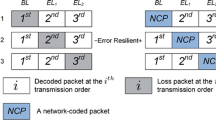Abstract
Recently, broadcast/multicast over cellular networks has been actively discussed over commercial wireless mobile terminals. Compared to conventional terrestrial or satellite broadcasting systems, the quality-of-service (QoS) for edge users is an important issue due to inter-cell interference over multi-cell environments. In this paper, we introduce a dynamic bandwidth and carrier allocation (DBCA) technique by fully utilizing different visual importance of each layer in multi-layer video for broadcast/multicast services when the number of users is limited over macro/micro/femto cell environments. To ensure an acceptable video quality for edge users, the bandwidth and the loading ratio are dynamically controlled to enhance the utility through the radio resource control in accordance with the visual importance. The simulation results show that DBCA exhibits much better QoS by sending visually more important data with high priority in the cell border region.
Similar content being viewed by others
References
Ghosh A., Wolter D., Andrews J., Chen R. (2005) Broadband wireless access with WiMAX/802.16: Current performance benchmarks and future potential. IEEE Communications Magazine 43: 129–136
Dahlman E., Jou Y. (2006) Further evolution of 3G radio access. IEEE Communications Magazine 44: 34–35
Li B., Qin Y., Low C.P., Gwee C. L. (2007) A survey on mobile WiMAX. IEEE Communications Magazine 45: 70–75
3GPP-TS-23.246. (2004). MBMS architecture and functional description (Release 6).
Boni, A., Launay, E., Mienville, T., & Stuckmann, P. (2004). Multimedia broadcast multicast service—technology overview and service aspects. In 3G Mobile Communications Technologies 2004, pp. 634–638.
Sehlstedt M., LeBlanc P. (2006) A computability strategy for optimization of multiresolution broadcast systems: A layered energy distribution approach. IEEE Transactions on Broadcasting 52: 11–20
Correia A., Silva J., Souto N., Silva L., Boal A., Soares A. (2007) Multi-resolution broadcast/multicast systems for MBMS. IEEE Transactions on Broadcasting 53: 224–234
Park J., Lee H., Lee S., Bovik A. C. (2009) Optimal channel adaptation of scalable video over a multi-carrier based multi-cell environment. IEEE Transactions on Multimedia 11: 1062–1071
Khansari M., Jalali A., Dobios E., Mermelstein P. (1996) Low bit-rate video transmission over fading channels for wireless microcellular systems. IEEE Transactions on Circuits and Systems for Video Technology 6: 1–11
Jang U., Lee H., Lee S. (2008) Optimal carrier loading control for the enhancement of visual quality over ofdma cellular networks. IEEE Transactions on Multimedia 10: 1181–1196
Sternad, M., Ottosson, T., Ahlen, A., & Svensson, A. (2003). Attaining both coverage and high spectral efficiency with adaptive ofdm downlinks. In IEEE VTC 2003 Fall 4, pp. 2486–2490, Orlando, USA.
Wie, S. H., & Cho, D. H. (2001). Joint time slot allocation scheme based on a region division in CDMA/TDD systems. In IEEE VTC 2001 Spring 4, pp. 2445–2449, Rhodes, Greece.
Son H., Lee S. (2006) Bandwidth and region division for bradband multicell networks. IEEE Communications Letters 10: 360–362
Oh T., Lee S., Gil G.-T. (2009) Increasing throughput and QoS using bandwidth and region division with frequency overlay over multicell environments. IEICE Transactions on Communications E 92(B): 85–92
Winker S. (1999) Issues in vision modeling for perceptual video quality assessment. Signal Processing 78: 231–252
Lee S., Pattichis M. S., Bovik A. C. (2001) Foveated video compression with optimal rate control. IEEE Transactions on Image Processing 10: 977–992
Wang Z., Bovik A. (2001) Embedded foveation image coding. IEEE Transactions Image Processing 10: 1397–1410
Lee S., Pattichis M. S., Bovik A. C. (2002) Foveated video quality assessment. IEEE Transactions on Multimedia 4: 129–132
Choi W., Kim J. Y. (2001) Forward-link capacity of a DS/CDMA system with mixed multirate sources. IEEE Transactions on Vehicular Technology 50: 737–749
Beaulieu, N. C., Abu-Dayya, A. A., & McLane, P. J. (1994). Comparison of methods of computing lognormal sum distributions and outages for digital wireless application. In IEEE ICC’94 41, pp. 1270–1275, New Orleans, USA.
Simon M. K., Alouini M.-S. (2005) Communication over fading channels, 2nd edn. Wiley, New Jersey
Ho, M. J., & Stuber, G. L. (1993). Co-channel interference of microcellular systems on shadowed nakagami fading channels. In IEEE VTC 1993, pp. 568–571.
Arnbak J., van Blitterswijk W. (1987) Capacity of slotted aloha in Rayleigh-fading channels. IEEE Journal on Selected Areas in Communications 5: 261–269
Author information
Authors and Affiliations
Corresponding author
Rights and permissions
About this article
Cite this article
Oh, T., Lee, H. & Lee, S. Dynamic Bandwidth and Carrier Allocation for Video Broadcast/Multicast Over Multi-Cell Environments. Wireless Pers Commun 69, 1925–1945 (2013). https://doi.org/10.1007/s11277-012-0671-x
Published:
Issue Date:
DOI: https://doi.org/10.1007/s11277-012-0671-x




